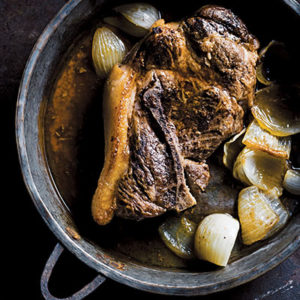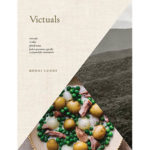 Thrifty homesteaders knew how to cook all cuts of the hogs that were slaughtered in the winter. The shoulder, slow-roasted with fat and bone, produced a richly textured, deeply flavored meat worth smacking your lips for. Modern mountain cooks use the slow cooker to create the same effect that roasting in a woodstove, kept going all day for heat as well as cooking, once provided.
Thrifty homesteaders knew how to cook all cuts of the hogs that were slaughtered in the winter. The shoulder, slow-roasted with fat and bone, produced a richly textured, deeply flavored meat worth smacking your lips for. Modern mountain cooks use the slow cooker to create the same effect that roasting in a woodstove, kept going all day for heat as well as cooking, once provided.
I buy pork from one of several producers in my neck of the Blue Ridge who pasture their pigs and process them humanely. They also tend to raise heritage pigs that naturally come with more fat, and the cuts I favor reflect that. The last roast I cooked like this weighed about 3-1/2 pounds at the market with a top fat layer about an inch deep. I trimmed that fat to 1/2 inch and the roast was then about 3 pounds.
 Reprinted from Victuals. Copyright © 2016 by Ronni Lundy. Photographs copyright © 2016 by Johnny Autry. Published by Clarkson Potter/Publishers, an imprint of Penguin Random House, LLC.
Reprinted from Victuals. Copyright © 2016 by Ronni Lundy. Photographs copyright © 2016 by Johnny Autry. Published by Clarkson Potter/Publishers, an imprint of Penguin Random House, LLC.
ON-DEMAND: Listen to Faith and Ronni discuss this recipe on The Faith Middleton Food Schmooze®.
- 1/2 tablespoon salt
- 1/2 teaspoon freshly ground black pepper
- 1 3-pound Pork shoulder or butt bone-in
- 2 tablespoons apple cider vinegar
- 1 tablespoon Sorghum syrup (sometimes labeled as sorghum molasses)
- 1 small yellow onion
- 1 tablespoon cornstarch
- Rub the salt and pepper into all sides of the roast, including the top fat. Place a heavy skillet over high heat and as it is warming up, place the roast in the skillet, fat side down. The heat will render enough fat for browning the rest of the roast without sticking. When there is enough fat to coat the bottom of the pan well and the fat on the roast is turning golden brown, flip the roast over and brown the next side.
- Brown all sides of the roast. This may entail using tongs to hold the roast to brown the short edges, but it only takes a minute or so and is worth it since it will intensify the flavor. You may also need to spoon some of the rendered fat out of the skillet as you are browning—the point is to sear the meat, not deep-fry it.
- When the roast is browned all over, place it in a slow cooker. Carefully pour off the grease from the skillet. Add 1/2 cup of water to the skillet and deglaze it. Remove the skillet from the heat and add the vinegar and sorghum, stirring to dissolve the syrup. Pour this mixture into the slow cooker.
- Peel the onion, quarter it, and break apart the sections. Scatter the pieces around the edge of the roast in the pot. Cover, and cook on the high setting for 30 minutes. Then turn to low and cook for 4 hours.
- The pork roast will be well done but meltingly tender when the inner temperature is 165°F. Remove it from the pot and allow it to rest under a tent of foil while you make the sauce.
- Strain the pan juices to remove the onion pieces. Degrease the juices and pour them into a small pot set over medium-high heat. In a small bowl, whisk the cornstarch with ½ cup of water to form a slurry. When the juices in the pot begin to bubble, whisk in the cornstarch slurry. Continue to whisk as the mixture bubbles for about a minute and thickens. Remove from the heat.
- To carve the roast, begin on the side away from the bone to yield larger, uniform pieces. Pass the sauce on the side.
This makes a wonderful winter meal served with individual baked sweet potatoes.


